Monastic medicine: medieval herbalism meets modern science Understand article
A group of German researchers is bringing to light the medicinal wisdom of the Middle Ages.
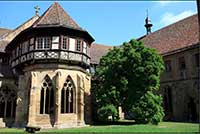
Cistercian abbey of
Maulbronn, in southern
Germany, preserved and
transmitted important
knowledge about herbal
medicine in the Middle Ages.
Image courtesy of WeiterWinkel
/ Flickr
Most people think of herbal medicine as a distinctly ‘alternative’ option – something that you might try for a cough or cold that won’t budge, but not for life-threatening illnesses. Medical historian Dr Johannes Mayer, however, takes it all much more seriously: he believes that the herbal remedies described in medieval texts can provide excellent starting points for highly effective modern treatments, even for diseases such as cancer. And he is not alone, as his work has already attracted the attention (and funding!) of pharmaceutical giant GlaxoSmithKline.
The focus for Dr Mayer’s research group at the University of Würzburg, Germany, is monastic medicine (Klostermedizin in German). For the past 30 years, group members have been sifting through monastic manuscripts dating from the 8th century onwards, translating and publishing details of plant remedies and the ailments that they are intended to treat.
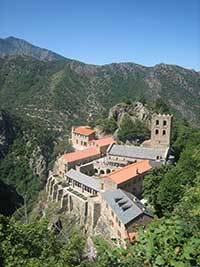
Canigou was built in the
10th century in the South of
France. It had a herbalgarden
where many types of
localmedicinal plant were
grown.
Image courtesy of Isabelle
Kling
Their work moved from the historical towards the more scientific some 14 years ago, when the group received a visit from a manager at GlaxoSmithKline. When the visitor asked “What is monastic medicine? Is it praying or something?”, Dr Mayer explained that in fact it meant elucidating the herbal treatments documented by monasteries and investigating their physiological effects.
That visit led to a research group being established at the university, with sponsorship from GlaxoSmithKline, to look for effective modern remedies derived from medieval monastic knowledge. So far the collaboration has led to the development of some products to treat the common cold, sold under the appropriately named brand Abtei (German for ‘abbey’). The group now has other links with pharmaceutical companies, as well as with Würzburg University Hospital.
The initial source of such fruitful results is the huge range of historical texts. “First we tried to research the plants that were documented in monasteries used in the early and higher Middle Ages, between the 8th and 12th centuries,” says Dr Mayer. “But now we are researching the whole history of medicinal plants in Europe up to the modern day, looking for indications of what might be useful.”
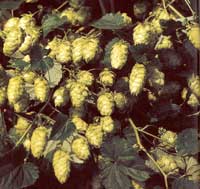
Klostermedizin research
group started a project
together with Abtei to
investigate the active
ingredients and mechanisms
by which hops (Humulus
lupulus) and valerian
(Valeriana officinalis) work
as sedatives (see, for
example, Schellenberg et al.,
2004). They found that the
lignans in hops function
similarly to adenosine, an
inhibitory neurotransmitter
that promotes sleep. Hops
work in a similar way to the
hormone melatonin, which
plays a role in the body clock.
Image courtesy of Heike Will
The research involves several steps: translating the texts (often from medieval Latin), identifying precisely which plant was used for which treatment – no easy task given the inconsistent and varied common names used for many plants – and then finding the active ingredients.
Some of these ingredients are then tested in laboratories at Würzburg University Hospital or at their partner pharmaceutical companies. For example, scientists in the ear, nose and throat department at the hospital are currently testing the effect of water- and alcohol-based extracts of Osmunda regalis (old world royal fern) and Chelidonium majus (greater celandine) on cultures of ear cancer cells. Finally, a few promising leads have been passed on for development as potential new drugs, undergoing clinical trials and other testing to conform to legislative requirements. If the fern and celandine extracts prove effective, for example, the clinical trials will be carried out at the hospital.
This complex process is reflected in the multidisciplinary expertise of Dr Mayer’s team, which comprises academics from a variety of backgrounds: historians of medicine and scholars of Latin and ancient Greek, plus chemists, biologists and pharmacists – all of whom are needed to fully understand the medieval recipes. There are also outside specialists that the group can call on – including a Cistercian monk who is a biologist.
Dr Mayer’s own background is in history. “I first studied history, and then the history of medicine and that’s how I found out that we didn’t know what plants they really were using in the Middle Ages. So I started to make a database about historical plants used in Europe,” he says.
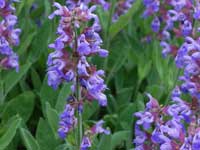
sage, is mentioned in
medieval manuscripts as
being useful for improving
memory. Recent research at
the University of Newcastle,
UK, has shown it to be
effective in this role (it
appears to help reduce the
breakdown of the
neurotransmitter
acetylcholine), which makes
it a candidate for the
development of a treatment
for dementia (Scholey et al.,
2008). Drug development
and clinical trials take time,
however, so Dr Mayer
expects it will be another
ten years before a drug
based on sage becomes
available.
Image courtesy of Heike Will
Although most of the key texts are written in Latin, in many cases this is a translation from earlier texts written in Arabic, some of which also contain knowledge preserved from ancient Greek authors such as Aristotle. As Dr Mayer explains: “In the early Middle Ages there was not much literature here in Europe, and Pliny the Elder (23-79 AD) was the most important antique author for monastery medicine. Then in the 11th century, they started to translate Arabic texts into Latin, and so a lot of new plants came into European medicine.”
One example of this is Alpinia officinarum, a plant used to treat respiratory problems and also for relaxation. Although this plant is endemic to Europe, its medicinal use started only after the Arabic medicine texts arrived.
In time, the translation of Arabic texts came to overshadow the epoch of monastic medicine because it led to the foundation of many universities in the 13th century. So from this time onwards there were professional physicians, and monastic medicine became less important.
There was, however, a new period of monastic medicine in the 16th century, because many missionaries sent to the newly discovered lands in the Americas were monks. “The missionaries were interested in finding out what the native Americans did with the special plants in Central and South America. So they wrote books about the use of these plants, and sent the information back to Europe,” says Dr Mayer.
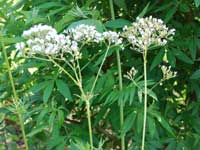
Image courtesy of Heike Will
Today, Dr Mayer’s group collaborates not only with industry but also with working monasteries, advising on special plants to grow in the monastery gardens and on their uses in tea-style infusions and in lotions. They even run courses for the public at the local monastery in Oberzell – which brings in some useful additional funding for the group.
Dr Mayer has found that cultivating plants is not always the best way to obtain them, either because it’s hard to get them to grow or because the ingredients obtained from wild plants are better than those from cultivated plants.
“You must go out in the woods to find these plants, like Arnica montana; it’s very difficult to cultivate the plants and to get enough flowers,” he says. “But in the wild it grows well.” Which is perhaps a fitting reminder of the fabulous complexity of nature, as evident today as it was to the people of the Middle Ages.
Reliable remedies
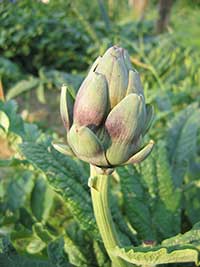
problems.
Image courtesy of Richardfabi/
Wikimedia
Although many plants have been used traditionally in medicine, few have been investigated scientifically to find out whether they are indeed safe and effective remedies for the conditions they are said to treat. In addition to laboratory studies, such as those carried out by Dr Mayer’s group, the clinical efficacy of a treatment also needs to be tested.
Scientists agree that the best way to find out the effect of a treatment is via a high-quality clinical trial, or RCT (randomised controlled trial). These include several precautions to make sure the trial results are free from bias:
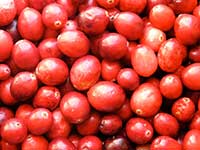
urinary tract infections.
Image courtesy of Liz West /
Wikimedia
- The treatment being studied is compared to one or more alternative control treatments, including a placebo (one that has no direct pharmacological effect, such as a sugar pill).
- Participants in the trial are randomly assigned to the different treatments.
- Neither the patients themselves, nor the people giving them the treatment, know which treatment each has been given; this is called double-blinding.
- The trial needs to have enough people taking part so that the results could not easily have occurred by chance (the more data there is, the less likely this is to happen).
While this all may seem very complicated, without these precautions the results could easily be due to factors other than the treatment itself, so they would not be reliable. Even when a high-quality study has been done, the results need to be examined alongside those from other such trials to see what the total evidence suggests. (To learn more about clinical trials, see Garner & Thomas, 2010, and Brown, 2011.)
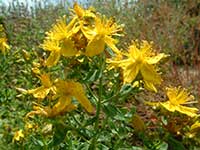
proven in clinical trials to be
effective at treating
depression.
Image courtesy of Heike Will
Herbal treatments that are supported by good-quality evidence include these:
- Artichoke (Cynara scolymus) can aid digestive problems as it increases the flow of bile, which helps to digest fats. See The Handbook of Clinically Tested Herbal Remediesw1 for evidence.
- Cranberry (Vaccinium macrocarpon) may help prevent urinary tract infections: drinking cranberry juice is thought to make bacteria less able to adhere to walls of the urinary tract. (However, a recent evidence review concluded cranberry is less effective than previously thought.) See the Cochrane Collaboration websitew2 for evidence.
- St. John’s wort (Hypericum perforatum) is as effective in treating depression as some pharmaceutical antidepressants, but like them it can also have side effects. See The Handbook of Clinically Tested Herbal Remediesw1 for evidence.
Class activity
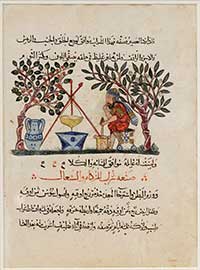
the De Materia Medica by
Dioscorides (ca. 40-90 AD),
showing a physician
preparing an elixir. From Iraq
or Northern Mesopotamia,
perhaps Baghdad.
Public domain image /
Wikimedia Commons
Students can carry out their own research into herbal medicines that have been shown to be effective – or not. Perhaps ask them to investigate some commonly used herbal remedies (e.g. echinacea, evening primrose, gingko, ginseng, valerian) and to explain what the available information suggests and how reliable they think this is.
One of the best resources to find out about the efficacy of medicines of all kinds is the Cochrane Collaboration websitew2. The Cochrane Collaboration produces reviews of clinical trials data to establish whether there is good evidence that a treatment is effective. The reviews can be accessed via the Cochrane website.
Another resource is The Handbook of Clinically Tested Herbal Remediesw1 by Marilyn Barrett (2004), which can also be accessed online. The author has compiled evidence from trials of more than 30 commonly used herbal remedies, together with reviews of each trial and a rating of the quality of the evidence that each provides (graded I, II or III).
References
- Brown A (2011) Just the placebo effect? Science in School 21: 52-56.
- Garner S, Thomas R (2010) Evaluating a medical treatment. Science in School 16: 54-59.
- Schellenberg R et al. (2004) The fixed combination of valerian and hops (Ze91019) acts via a central adenosine mechanism. Planta Medica 70(7): 594–597
- Scholey AB et al. (2008) An extract of Salvia (sage) with anticholinesterase properties improves memory and attention in healthy older volunteers. Psychopharmacology 198:127–139. doi: 10.1007/s00213-008-1101-3
Web References
- w1 – A good compilation of evaluative information about herbal treatments is: Barratt M (2004) The Handbook of Clinically Tested Herbal Remedies Volume 2. USA: Haworth Press, Inc. ISBN: 0-7890-2724-0.
- w2 – The Cochrane Collaboration produces reviews of clinical trials data, including trials of herbal medicines, which can be accessed via the Cochrane website.
- The most recent review of evidence for the effectiveness of cranberries in the prevention of urinary tract infections showed no significant benefit.
Resources
- The Science and Plants for Schools website offers a teaching resource about medicines and drugs from plants. Using a card-game format, the activity is suitable for teaching students aged 16+ about plant-derived pharmaceuticals, or it could be used to introduce younger students to poisons.
- To learn more about Arabic science and medicine between the 7th and 17thcenturies, see:
- Khan Y (2006) 1000 years of missing science. Science in School 3: 67-70.
- To learn more about the work of Dr Mayer’s research group, visit the Forschergruppe Klostermedizin website (in German).
Review
It is widely known that herbs are useful in everyday life in a number of different ways; this article describes one such application – how medieval monastic herbs can be used as a source of modern medicines. Of great interest is the obvious link between history, religious studies and science disciplines such as plant biology, chemistry and pharmacy. Equally interesting is the complex procedure involved in extracting useful information from medieval monastic manuscripts. Overall, the article shows beautifully how knowledge can be transferred across time and different civilisations.
The article is an excellent source of information for interdisciplinary lessons. Relevant topics could include:
- Natural ingredients for modern medicines
- Using old wisdom for new discoveries
- How knowledge is transferred across time and different civilisations.
Suitable comprehension questions include:
- Why is it difficult to gather useful information about herbs that could be used to treat illnesses?
- The pharmaceutical industry normally relies on the combined work of biologists, chemists, pharmacists and doctors to develop a new drug. In the case of the monastic medicines described in this article, researchers from a wider spectrum of disciplines are needed. Explain why this is the case.
- Once useful medicinal herbs have been identified, why can it be difficult to source large amounts of the specific herbs or their active ingredients?
Michalis Hadjimarcou, Cyprus





